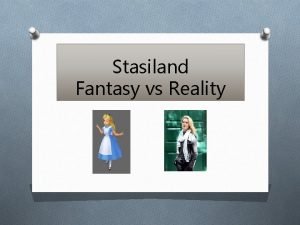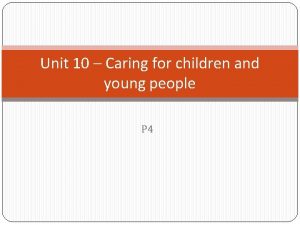Fantasy and Reality Distinction in Young Children and

- Slides: 1

Fantasy and Reality Distinction in Young Children and Adults Sarah Hohl & Justin J. Couchman Albright College Methods 6). Post-intervention understanding was predicted to be higher than pre-intervention understanding, and we expected an age X intervention interaction, where younger children show more improvement (pre vs. post) than older children. We hypothesize that participants will categorize actors correctly and characters from movies incorrectly. Categorization of movie characters will have less accuracy than categorization of actors as participants continue the study, and response times will be longer for movie character pictures but shorter for actor pictures. Thanks to the Patt Family ACRE Endowed Fund for support that made this project possible, to the ACRE Program at Albright College, and to the Honors Committee at Albright College. Experiment 2: v 16 adults, Mean age = 19. 125 v Categorized 36 pictures of actors and actresses in their movie roles and outside their movie roles 0. 9 v Each picture was labeled “REAL” or “IMAGINARY” and 0. 8 participants categorized the pictures by clicking “Yes” or “No’ 0. 7 Proportion Correct 0. 6 0. 5 0. 4 0. 3 0. 2 0. 1 0 Pre-intervention performance Post-intervention performance Pre-intervention imaginary performance Three-year-olds Pre-intervention real performance Four-year-olds Post-intervention imaginary performance Post-intervention real performance Five-year-olds 0. 9 0. 8 0. 7 0. 6 0. 5 0. 4 0. 3 0. 2 0. 1 0 Pre-intervention performance Post-intervention performance Pre-intervention imaginary performance Three-year-olds Pre-intervention real performance Four-year-olds Experiment 1 v Analyzed using a dependent t-test and one-way dependent ANOVA 1. 65 v Recoding of the data was necessary to complete further analysis, recoded from 1. 6 “real” or “imaginary” to “correct” or “incorrect”, then to 1 meaning “real” and 2 1. 55 meaning “imaginary” 1. 5 v Dependent t-test 1. 45 v Pre-intervention performance and post-intervention performance, t(23) = 1. 4 0. 193 1. 35 v Pre-intervention imaginary performance and pre-intervention real 1. 3 performance, t(23) = 0. 158 Real Categorization Imaginary Categorization v Post-intervention imaginary performance and post-intervention real performance, t(23) = 0. 060 v Repeated measures one-way ANOVA v Pre-intervention performance vs post-intervention performance, F(1, 21) = 1. 91 2 2. 566, ns, η = 0. 109 1. 86 v No significant effect of age in pre-intervention and post-intervention performance, F(2, 21) = 1. 296, ns, η 2 = 0. 110 1. 81 v Effect of age that approached significance, F(2, 21) = 2. 620, p = 0. 096, η 2 = 1. 76 0. 200 v Pre-imaginary vs pre-real performance, F(1, 21) = 0. 300, ns, η 2 = 0. 014 1. 71 v Pre-imaginary vs pre-real performance by age, F(2, 21) = 0. 030, ns, η 2 = 1. 66 0. 026 Real Categorization Imaginary Categorization v Effect of age that approached significance, F(2, 21) = 3. 336, p = 0. 055, η 2 = 0. 241 v Post-intervention imaginary vs post-intervention real performance, F(1, 21) = 2. 950, ns, η 2 = 0. 123 v Pre-imaginary vs pre-real performance by age, F(2, 21) = 0. 234, ns, η 2 = 0. 022 v No significant effect of age, F(2, 21) = 0. 556, ns, η 2 = 0. 050 v Repeated measures one-way ANOVA without five-year-olds v Pre-intervention performance vs post-intervention performance, F(1, 20) = 1. 071, ns, η 2 = 0. 051 v Pre-intervention performance vs post-intervention performance by age, F(1, 20) = 0. 074, ns, η 2 = 0. 081 v Significant effect of age, F(1, 20) = 4. 857, p < 0. 05 v Pre-intervention imaginary performance vs pre-intervention real performance, F(1, 20) = 2. 350, ns, η 2 = 0. 105 v Pre-intervention imaginary performance vs pre-intervention real performance by age, F(1, 20) = 0. 008, ns, η 2 = 0. 000 v Significant effect of age, F(1, 20) =6. 253, p < 0. 05 η 2 = 0. 238 v Post-intervention imaginary performance vs post-intervention real performance, F(1, 20) = 2. 784, ns, η 2 = 0. 122 v Post-intervention vs post-intervention performance by age, F(1, 20) = 0. 258, ns, η 2 = 0. 013 v Dependent t-test for three-year-olds only v Pre-intervention vs post-intervention, t(10) = 0. 714, ns v Pre-intervention imaginary vs pre-intervention real, t(10) = 0. 430 v Post-intervention imaginary vs post-intervention real, t(10) = 0. 537, ns v Dependent t-test for four-year-olds only v Pre-intervention vs post-intervention t(10) = 0. 227, ns References Discussion and Future Directions v Pre-intervention imaginary vs pre-intervention real, t(10) = 0. 121, ns v Barbieri, G. L. , Bennati, S. , Capretto, S. , Ghinelli, B. , & Vecchi, C. (2016). Imagination in narrative medicine: A case study in a children’s hospital in Italy. Journal of Child Health Care, 20(4), 419– 427. v Post-intervention imaginary vs post-intervention real performance, t(10) = p < v Overall, results supported previous research in that doi: 10. 1177/1367493515625134 v Clark, C. (1995). Flights of fancy, leaps of faith: Children’s myths in contemporary America. Chicago: 0. 05 younger children have more difficulty understanding the University of Chicago Press. v Eberle, S. G. (2014). The elements of play: Toward a philosophy and definition of play. American distinction between real and imaginary and the Journal of Play, 6(2), 214– 233. Experiment 2: v Kudriavtsev, V. T. , & Fattakhova, D. I. (2015). The child on the threshold of becoming a pupil: intervention appeared to even the understandings of real Imagination as a condition for the development of interaction among older preschoolers. Journal of v Dependent t-test was conducted, measured accuracy and time Russian & East European Psychology, 52(3), 1– 15. doi: 10. 1080/10610405. 2015. 1175832 and imaginary of the three-year-old children with the four- v Martarelli, C. S. , & Mast, F. W. (2013). Is it real or is it fiction? Children’s bias toward reality. Journal of v Accuracy of categorization for real and imaginary, t(15) = 3. 865, p < 0. 05 and five-year old children Cognition and Development, 14(1), 141– 153. https: //doiorg. felix. albright. edu/10. 1080/15248372. 2011. 638685 Timing for real and imaginary pictures, t(15) = 0. 632, ns vv Results for accuracy of categorization of pictures for v Martarelli, C. S. , Mast, F. W. , Läge, D. , & Roebers, C. M. (2015). The distinction between real and fictional worlds: Investigating individual differences in fantasy understanding. Cognitive adults concluded participants categorized pictures Development, 36, 111– 126. https: //doi-org. felix. albright. edu/10. 1016/j. cogdev. 2015. 10. 001 v Prentice, N. M. , Manosevitz, M. , & Hubbs, L. (1978) Imaginary figures of early childhood: Santa Claus, accurately according to the labels of “REAL” and Easter Bunny, and the Tooth Fairy. American Journal of Orthopsychiatry, 48, 618 -628. v Rosengren, K. S. , Kalish, C. W. , Hickling, A. K. , & Gelman, S. A. (1994). Exploring the relation between “IMAGINARY” but were slower when categorizing preschool children’s magical beliefs and casual thinking. British Journal of Developmental Psychology, pictures labeled as imaginary. 12, 69 -82. v Sharon, T. , & Woolley, J. D. (2004). Do monsters dream? Young children’s understanding of the v A more diverse range of ages and a greater sample size fantasy/reality distinction. British Journal of Developmental Psychology, 22(2), 293– 310. doi: 10. 1348/026151004323044627 and changes to the intervention or type of categorization Accuracy Experiment 1: v 24 children from the Albright Early Learning Center v 11 three-year olds, 11 four-year olds, and two fiveyear olds v Mean age = 3. 625 v Children were given consent forms which their parents signed to allow their participation in the study and each child gave verbal assent to participating in the study v Pre-intervention: v Ten pictures, five real things and five imaginary things v Intervention v The researcher demonstrated the difference between real objects and the imaginary counterparts by telling each child if the object was real or imaginary v Items used were an apple/toy apple, hammer/toy hammer, i. Pad/toy i. Pad, cell phone/toy cell phone, and researcher/doll v Post-intervention: v Ten pictures, different set from the pre-intervention v Five real things and five imaginary things v Participants were asked to categorize each picture as real or imaginary, verbally or by placing it on the “R” or the “I” v One week after the pre-intervention was completed, the intervention and post-intervention was completed, and the same categorization task was used for the postintervention Proportion Correct Imagination is an abstract concept that children somehow have mastered at a young age and are able to play and pretend with others, using their imagination. Experiment 1 examines what children understand to be real and imaginary and if this understanding is altered in any way after showing them the difference with real and fake objects. A pre-intervention and postintervention study was designed to test what children understand whether showing them the difference between real and imaginary improves their understanding of the distinction. Participants categorized a set of ten pictures before an intervention by the researcher which demonstrated the difference between real and imaginary and categorized a separate but equivalent set of pictures after the intervention. Results supported previous findings showing that younger children have a harder time understanding real and imaginary. Experiment 2 examines preliminary research for adult perception of real and fantasy by using a categorization task in which participants categorized pictures of actors and movie characters into categories for real and Background imaginary and reaction time was measured. Results indicated vadults accurately categorized both real and imaginary pictures but Imagination in the brain and as a developmental component tended to have slower reaction times to imaginary pictures. v Vygotsky (2004) discusses how the brain’s plasticity allows it to retain previous experiences, the reproduction of these experiences and generation of new ideas and thoughts is known as “imagination” or “fantasy” v Play and its effect on the imagination v Play makes demands of the muscular and neural systems which develops physical and mental abilities and imagination develops social skills as imagined play needs to be communicated (Eberle 2014) v Kudriavtsev and Fattakhova (2015) discuss the benefits of play as it creates a foundation for learning for when children need to think abstractly, generally, and for social cues v Barbieri, Bennati, Capretto, Ghinelli, and Vecchi, (2016) conducted a study in Italy that demonstrated imagination to be helpful to children to express their emotions and thoughts in a positive way v Fantasy and reality distinction v Sharon and Woolley (2004) assessed children’s capabilities to categorize real and fantastical entities and their fantasy orientation and found younger children have more difficulty understanding the distinction between fantasy and reality v Bjorklund (1989) studied pre-school aged children and found a child’s ability to distinguish reality from fantasy improves over the preschool years v Fantasy and reality distinction in adults v Most studies use adults as a control group and comparisons to children’s performance on tasks involving imagination or fantasy v Martarelli and Mast (2013) used adults for comparative Hypotheses measures when testing if children have a bias towards reality to ensure the stimuli were not ambiguous from an Younger children (ages 2 -4) would find it more difficult to “adult point of view” distinguish fantasy from reality than older children (ages 5 - Results Timing Abstract

